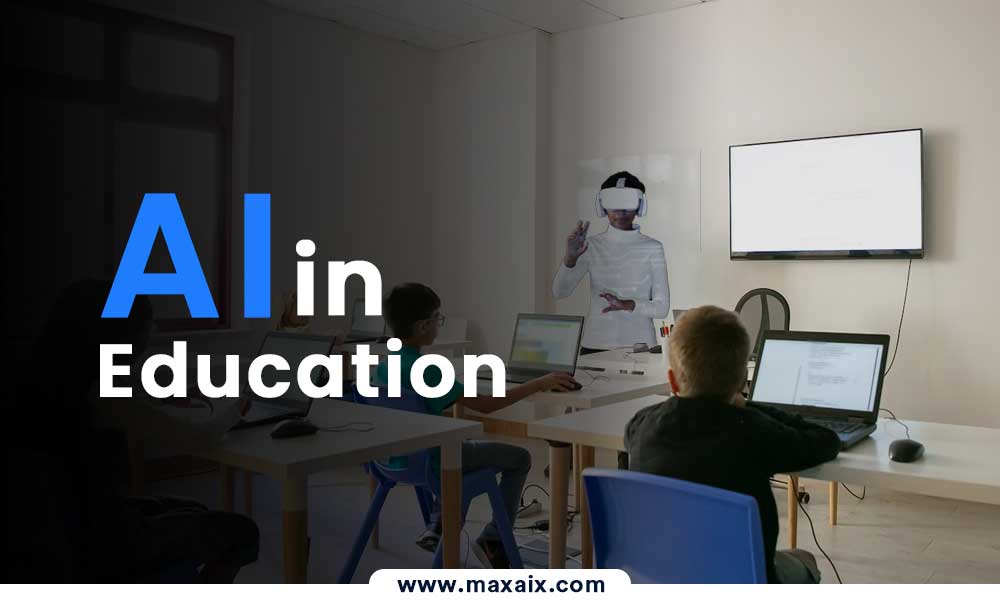10 Ways AI in Education is Transforming the Industry

Introduction: Revolutionizing Learning with AI-Driven Education
In the ever-evolving landscape of education, Artificial Intelligence (AI) has emerged as a transformative force, reshaping the way we teach and learn. As we delve into the 21st century, the integration of AI-driven education is becoming increasingly prevalent, with a myriad of applications and benefits. This comprehensive guide explores the profound impact of AI in education, focusing on 10 cutting-edge apps that are leading the revolution in the United States, Canada, and the United Kingdom.
The Intersection of AI and Education:
Artificial Intelligence, with its ability to process vast amounts of data and perform complex tasks, has found a natural home in education. The marriage of AI and education has given rise to personalized learning experiences, data-driven insights, and innovative approaches to teaching. From virtual tutors to adaptive assessments, the possibilities are limitless.
Key Focus Areas:
1. Adaptive Learning: Tailoring educational content based on individual student needs.
2. Virtual Tutoring: Providing personalized guidance and support.
3. Predictive Analytics: Anticipating student performance and intervention needs.
4. Automated Grading: Streamlining assessment processes for educators.
5. Smart Content: Creating dynamic, interactive learning materials.
6. Gamification: Integrating game elements to enhance engagement.
7. Language Processing: Facilitating language learning through AI-driven tools.
8. Learning Analytics: Extracting actionable insights from student data.
9. Robotics in Education: Enhancing hands-on learning experiences.
10. AI-Enhanced Assessment: Modernizing evaluation methods for educators.
This guide explores each of these focus areas, shedding light on the innovative AI-driven education apps making waves in the educational landscape.
What is the way forward with AI and education?
AI in education brings forth a myriad of advantages, revolutionizing the traditional learning landscape.
- Personalized Learning: AI customizes learning, allowing each learner to acquire knowledge at their own pace.
- Adaptive Learning: AI-driven computer systems adjust the pace according to the students’ understanding and memorizing capabilities.
- Efficient Resource Allocation: Automation enhances efficiency in terms of time and effort for teachers by effectively utilizing resources.
- Data-Driven Insights: Using big data, AI enables teachers to devise tailored interventions informed by the analysis.
- Enhanced Accessibility: The availability of learning resource materials, including AI content, promotes the inclusion principle, making them suitable for all students.
- Streamlined Administrative Tasks: Automation of administrative activities enables teachers to teach and coach their students effectively.
- 24/7 Learning Support: AI-powered chatbots and virtual assistants provide students with support 24/7.
- Gamified Learning: AI incorporates gamification to make learning fun, interactive, and interesting for learners.
- Predictive Analytics: AI predicts students’ achievements and identifies potential problems in their education.
- Global Collaboration: AI connects learners and teachers worldwide, fostering international teamwork.
What are the effects of the growth of educational apps on the world of education?
Education apps, driven by AI, have ushered in transformative changes globally.
- Accessibility: Education is not bound by distance due to mobile education applications that enable quality education everywhere.
- Customization: AI-enabled applications modify content to suit learners’ different preferences.
- Inclusivity: Educational apps foster integration since such apps cater to all kinds of students depending on their ability and preferred mode of study.
- Efficiency: In general, automation of administrative functions makes workflow more efficient by enabling teachers to concentrate on their major duty of classroom instruction.
- Global Collaboration: AI enables cross-border dialogue between learners and teachers for the enrichment of ideas.
- Continuous Learning: With education apps, students may learn whenever they want and have time on their side.
- Data-Driven Decision-Making: These AI analytics offer valuable data that enables teachers and other professionals to get the useful information required for making appropriate decisions.
- Lifelong Learning: Through lifelong learning, people can learn something by themselves through an education app with help.
- Engagement: The inclusion of gamified elements in educational apps enhances student engagement and motivational capacities.
- Personalized Feedback: Feedback through AI provides individual guidance on the way for enhancement.
AI-Driven Education Apps: Transforming Learning in the United States, Canada, and the United Kingdom
a. Duolingo: Language Learning Reinvented
Overview: The use of artificial intelligence is what makes the language learning experience personalized, interesting, and easily available.
Features: real-time feedback, adaptive learning paths, and gamified lessons.
Popularity: A very effective and easy-to-use interface that is widely used in the US, Canada, and the UK.
b. Khan Academy: providing free, top-quality education to anyone in any part of the world.
Overview: The use of AI is essential in enabling Khan Academy to offer free, quality education worldwide.
Features: adaptive practice, personalized learning dashboards, and detailed videos.
Popularity: It has a vast curriculum that is easily accessible both in the US, Canada, and the UK.
c. Coursera: The top universities offer online courses and learning.
Overview: The collaborations between colleges worldwide and how Coursera uses AI in adaptive learning experiences are some examples.
Features: customized courses, specialization degree programs, and artificial intelligence-based test evaluations.
Popularity: Well, it is widely accepted in the US, Canada, and the UK due to its diversified courses that endorse recognized certificates.
d. Quizlet: intelligent tools and flashcards
Overview: AI enables study tools and personalized learning through Quizlet.
Features: smart algorithms, adaptive learning techniques, and flexible modes of study.
Popularity: It is popular in the US, Canada, and the UK because it is customizable and students can generate their own course materials.
e. Edmodo: Working Together with People and Resources to Assist Students All Over
Overview: The Edmodo incorporates AI in connecting both educators and students, whereby they can cooperate and share their resources.
Features: The use of virtual classrooms, collaborative projects, and AI-driven analytics.
Popularity: Popular among US, Canada, and UK institutions because of collaboration capabilities coupled with a secure learning platform.
10 Ways AI in Education is Transforming the Industry
a. Adaptive Learning Platforms: Personalized learning paths based on individual progress.
b. Virtual Classrooms: Interactive online classrooms enhancing engagement.
c. Smart Content: AI-generated content tailored to individual learning styles.
d. Automated Grading Systems: Efficient assessment and prompt feedback.
e. Intelligent Tutoring Systems: Personalized guidance for better understanding.
f. Language Processing Apps: Enhancing language learning through AI-driven tools.
g. Educational Gaming: Gamified learning experiences for increased engagement.
h. Data-driven Insights: Analyzing student performance for strategic improvements.
i. Virtual Reality in Education: Immersive learning environments for enhanced understanding.
j. AI-driven Administration: Streamlining administrative tasks for educators.
The advantages of increased productivity in education apps through the custom software development by Maxaix
Adaptive Learning Paths: Maxxai utilizes AI, which adapts to each learner’s growth and comprehension.
Automated Assessments: Students are graded instantly by AI while teachers enjoy extra free time.
Personalized Recommendations: Maxaix AI assesses learning needs, providing customized content suggestions for boosted interest levels.
Learning Analytics: Through the use of analytics-driven by AI, educators are able to understand why students perform differently and identify areas to improve.
Virtual Assistants: Students have access to online assistance at any time in terms of responding to their questions and offering supplementary study materials through AI-based virtual assistants.
Each app is popular in the US, Canada, and the UK.
- Duolingo: Its easy interface, coupled with its language learning functionality, makes it appealing to users. Subsection B: Analysis Data ta. Subsection
- Khan Academy: Offers free education resources that are recognized as comprehensive and easy to learn.
- Coursera: Known for its partnerships with prestigious universities, a wide range of courses, and reputable qualifications.
- Quizlet: Often used due to its flexibility, adaptive learning materials, and student-authored studies.
- Edmodo: For its secure learning environment, collaboration, and ease of use,
- Squirrel AI: One of the most popular adaptive learning tools that has gained success in the realm of K–12 education.
- Robolink: Provides an engaged AI-enabled approach toward teaching coding and robotics.
- Classcraft: student engagement and a gamified approach in the classroom setting
- DreamBox: It is a widely employed technique that has proved to be effective in adapting math learning and progress tracking.
- Lingodeer: This is a common practice recognized by the UK as a method of language education and an interactive learning process.
5 Reasons: Why are people attracted by such applications?
- Accessibility: Educational apps are accessible, offering learning anytime and anywhere for users.
- Personalization: Personalized content that is powered by AI enhances understanding because it is specific and addresses each student’s needs.
- Engagement: Such elements as gamification and interactive tools increase user interest and motivate them to continue using an application or a website.
- Effectiveness: AI-driven learning instruments greatly impact users, including enhancing their skills and expertise.
- Global Collaboration: Educational apps enable cross-cultural cooperation, allowing learners to communicate with tutors from all over the world.
The cost of developing a learning app.
The cost of developing an education app depends on several factors:
App Features: Development costs are dependent on how complex or varied the features are.
Design: There may be a bearing of development costs on a user-friendly and attractive design.
Platform: The cost of development for iOS, Android, or both.
Location of Development: The cost of development may differ depending upon where the development team is from, either in a particular region or country.
Integration of AI: Including AI features in the development process may result in increased production and operational costs
Frequently Asked Questions
Q1: What sets apart AI-based educational applications?
The experience of personalized learning, adaptability to tailored learning pathways, and use of technology to enhance education make AI-driven education apps distinct.
Q2: What are the advantages of using AI-driven education apps for students?
The apps improve students’ experiences by providing personalized learning, fitting unique learning styles, and instant feedback to maximize understanding.
Q3: Can everyone use AI-based educational applications?
Yes, there are lots of educational-based programs that target different age categories, such as young children (from kindergarten to grade 12), college students, and adults.
Q4: How can AI influence gamified learning?
User engagement is improved through tailoring difficulties, prizes, and content to each learner’s unique pace and abilities.
Q5: Will AI be able to teach coding and robotics?
Yes, at Robolink, adaptive exercises are built by AI to teach coding and robotics, including intelligent projects and real-world applications.
Q6: What role does the use of education apps play in fostering collaborative efforts at a global level?
The education apps that involve AI connect students as well as teachers from all over the world, enabling the sharing of information, ideas, and experiences.
Q7: What makes these mobile education applications secure from a data perspective?
AI-enacted education applications are equipped with high safety standards that guard your information, enabling safe and non-public education settings.
Q8: Are education apps affordable to users?
Various educational apps, especially those with a paid or free trial like Khan Academy and Duolingo, are affordable to learners.
Q9: Can AI-based teaching mobile apps substitute for old methods of education delivery?
The AI-based education apps supplement conventional forms of teaching by providing extra materials, tailor-made lessons, and organizational assistance.


